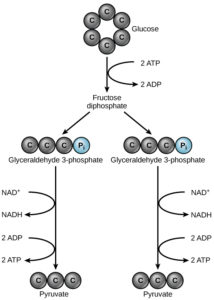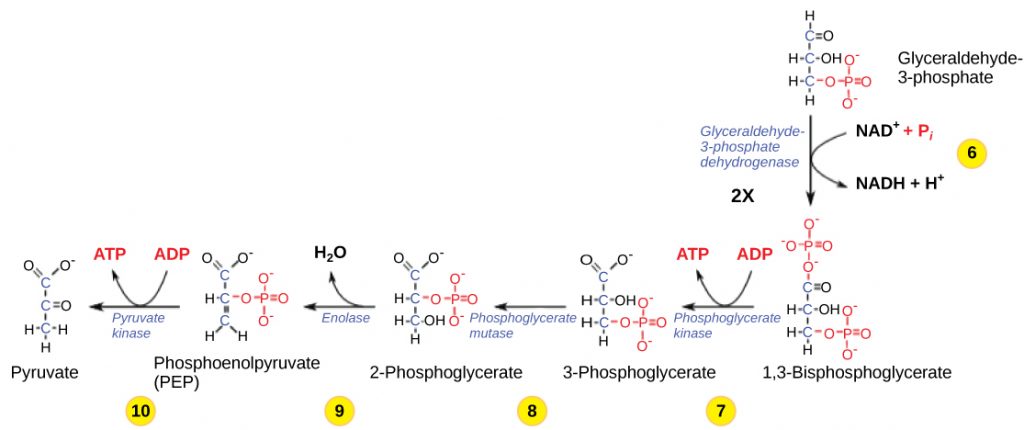Aerobic Respiration, Part 1: Glycolysis
You have read that nearly all of the energy used by living things comes to them in the bonds of the sugar, glucose. Glycolysis is the first step in the breakdown of glucose to extract energy for cell metabolism. Many living organisms carry out glycolysis as part of their metabolism. Glycolysis takes place in the cytoplasm of most prokaryotic and all eukaryotic cells.
Glycolysis begins with a molecule of glucose (C6H12O6). Various enzymes are used to break glucose down into two molecules of pyruvate (C3H4O3, basically a glucose molecule broken in half) (Figure 1). This process releases a small amount of energy.

Glycolysis consists of two distinct phases: energy-requiring, and energy-producing.
Energy-Requiring Steps
The first part of the glycolysis pathway requires an input of energy to begin. The first step in glycolysis is catalyzed by hexokinase, an enzyme with broad specificity that catalyzes the phosphorylation of six-carbon sugars. Hexokinase phosphorylates (adds a phosphate to) glucose using ATP as the source of the phosphate (Figure 2). This produces glucose-6-phosphate, a more chemically reactive form of glucose. This phosphorylated glucose molecule can no longer leave the cell because the negatively charged phosphate will not allow it to cross the hydrophobic interior of the plasma membrane.
Several additional enzymatic reactions occur (Figure 2), one of which requires an additional ATP molecule. At the end of the energy-requiring steps, the original glucose has been split into two three-carbon molecules, and two ATPs have been used as sources of energy for this process.

Energy-Producing Steps
So far, glycolysis has cost the cell two ATP molecules and produced two small, three-carbon sugar molecules. Both of these molecules will proceed through the second half of the pathway, and sufficient energy will be extracted to pay back the two ATP molecules used as an initial investment and produce a profit for the cell of two additional ATP molecules and two even higher-energy NADH molecules (Figure 3).
During the energy-producing steps, additional enzymes continue to catalyze the breakdown of glucose (Figure 3). The end result of these reactions is two 3-carbon molecules of pyruvate.

An important rate-limiting step occurs at step 6 in glycolysis. If you look at Figure 3, you will notice that during step 6, NAD+ is converted into NADH. NADH contains more energy than NAD+, and is therefore a desired product from this reaction. However, the continuation of the reaction depends upon the availability NAD+. Thus, NADH must be continuously converted back into NAD+ in order to keep this step going. If NAD+ is not available, the second half of glycolysis slows down or stops.
If oxygen is available in the system, the NADH will be converted readily back into NAD+ by the later processes in aerobic cellular respiration. However, if there is no oxygen available, NADH is not converted back into NAD+. Without NAD+, the reaction in step 6 cannot proceed and glycolysis slows or stops. In an environment without oxygen, an alternate pathway (fermentation) can provide the oxidation of NADH to NAD+.
Outcomes of Glycolysis
Glycolysis starts with glucose and ends with two pyruvate molecules, a total of four ATP molecules and two molecules of NADH. Two ATP molecules were used in the first half of the pathway to prepare the six-carbon ring for cleavage, so the cell has a net gain of two ATP molecules and 2 NADH molecules for its use. If the cell cannot catabolize (break down) the pyruvate molecules further, it will harvest only two ATP molecules from one molecule of glucose. Mature mammalian red blood cells are not capable of aerobic respiration—the process in which organisms convert energy in the presence of oxygen—and glycolysis is their sole source of ATP. If glycolysis is interrupted, these cells lose their ability to maintain their sodium-potassium pumps, and eventually, they die.
Section Summary
Glycolysis is the first pathway used in the breakdown of glucose to extract energy. It was probably one of the earliest metabolic pathways to evolve and is used by nearly all of the organisms on earth. Glycolysis consists of two parts: The first part prepares the six-carbon ring of glucose for cleavage into two three-carbon sugars. ATP is invested in the process during this half to energize the separation. The second half of glycolysis extracts ATP and high-energy electrons from hydrogen atoms and attaches them to NAD+. Two ATP molecules are invested in the first half and four ATP molecules are formed by substrate phosphorylation during the second half. This produces a net gain of two ATP and two NADH molecules for the cell.
What was produced (per molecule of glucose)?
- 2 pyruvate (3 carbon molecules), 2 NADH, net gain of 2 ATP
References
Unless otherwise noted, images on this page are licensed under CC-BY 4.0 by OpenStax.
OpenStax, Concepts of Biology. OpenStax CNX. May 18, 2016 http://cnx.org/contents/b3c1e1d2-839c-42b0-a314-e119a8aafbdd@9.10
OpenStax, Biology. OpenStax CNX. September 16, 2017 https://cnx.org/contents/GFy_h8cu@10.118:tYtpI6rX@6/Glycolysis

